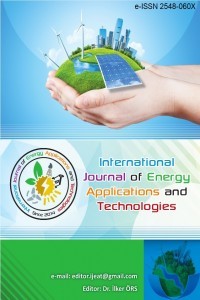THE EFFECT OF USE OF AIR CONDITIONER ON ENGINE VIBRATION IN GASOLINE CAR ENGINES
THE EFFECT OF USE OF AIR CONDITIONER ON ENGINE VIBRATION IN GASOLINE CAR ENGINES
Car engine vibration, AC, gasoline, stability,
___
- References [1] Rakheja, S. andSankar, S., “An Optimum Seat-Suspensionforoff-roadVehicles”, TheShockandVibrationBulletin, 53, pp. 19-35, 1983.
- [2] Weawer, B., “Ergonomics”, Pit&Quarry, Vol.October, pp. 20-22, 1991.
- [3] E. R. Engelhardt, D. K. Millsand K. Schneider, “ShockandVibrationHandbook (ShockandVibration in Road andRailVehicles)”, Mc-GrawHillBookCompanyInc., 1961.
- [4] Hostens, I.,Ramon, H. (2003). Descriptiveanalysis of combinecabinvibrationsandtheireffect on thehuman body. Journal of Sound andVibration, 266: 453-464.
- [5] Drugă, C.,Barbu, D., Lache, S. (2007). VibrationAndThe Human Body. Fascicle of Management andTechnologicalEngineering, 6 (16), 168-173.
- [6] Fonta, M.,Freitas, M. (2009). Marine main engine crankshaftfailureanalysis. EngineeringFailure Analysis, 16:1940-1947.
- [7] Karimi, H.R.,Lohmann, B. (2007). Haarwavelet-basedrobustoptimalcontrolforvibrationreduction of vehicle engine-body system. ElectricialEngineering, 89: 469-478.
- [8] Chu, C.C. (1997). Multiaxialfatigue life predictionmethod in thegroundvehicleindustry. International Journal of Fatigue, 19: 325-330.
- [9] Hoffman, D.M.W. (1999). In-lineinternalcombustion engine Dynamics andvibration. Ph. D. Thesis, TheUniversity of Michigan, 5-182.
- [10] Deck, C.L. (2005). Variability Analysis of Engine IdleVibration, M.Sc. Thesis, University of Windsor, 19-35.
- [11] Karabulut, H. (2012). Dynamic model of a two-cylinderfour-strokeinternalcombustion engine andvibrationtreatment. International Journal of Engine Research, 13: 616-627.
- [12] Hoffman, D.M.W.,Dowling, D.R. (2001). Fullycoupledrigidinternalcombustion engine dynamicsandvibration-Part II model-experimentcomparisons. Journal of EngineeringforGasTurbinesandPower, 123: 677-684.
- [13] Hadi R. (2002). Theidentification of theinertialcharacteristics of an ICE throughsteadystatevibrationmeasurement. Ph. D. Thesis, WayneStateUniversity, 5-47.
- [14] Tao, J.S.,Liui G.R. And Lam, K. Y. (2000). Design optimization of marine engine mountsystem. Journal of Sound andVibration, 235(3), 477-494.
- Yayın Aralığı: Yılda 2 Sayı
- Başlangıç: 2014
- Yayıncı: İlker ÖRS
Future Demand For Nuclear Energy In Turkey
Application of Rural Photovoltaic Water Pumping System Using Immersed Pump and DC Motor
THE EFFECT OF USE OF AIR CONDITIONER ON ENGINE VIBRATION IN GASOLINE CAR ENGINES
Murat MAYDA, Nurullah GÜLTEKİN, Ziya ÖZÇELİK, Bekir ÇIRAK
1P3S HIGH FREQUENCY TRANSFORMER BASED DUAL-ACTIVE BRIDGE DC-DC CONVERTER
Murat Mustafa SAVRUN, Tahsin KOROGLU, Adnan TAN, Mehmet Ugras CUMA, Kamil Cagatay BAYİNDİR, Mehmet TUMAY
